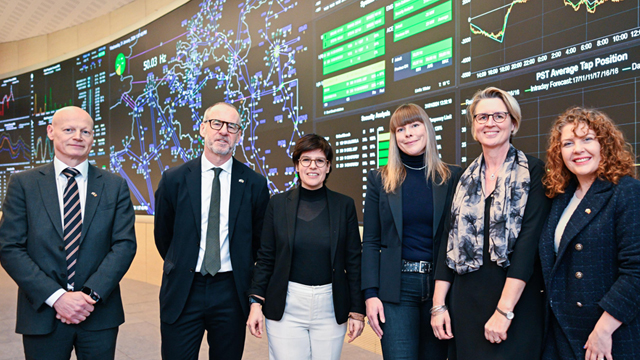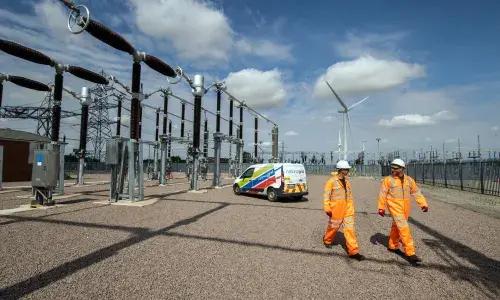
National Grid celebrates five years of its Nemo Link interconnector
- National Grid’s Nemo Link interconnector is celebrating its fifth anniversary
- Politicians and energy leaders have met in Brussels to mark the occasion
- The interconnector has saved 1.4 million tonnes of carbon since 2019 – equivalent to taking 650,000 cars off the road
- Nemo Link has capacity to provide enough power for 1.7 million UK homes
National Grid’s Nemo Link interconnector has saved 1.4 million tonnes of carbon since it launched five years ago – equivalent to taking 650,000 cars off the road.*
Some 29 terawatt hours (TWh) of power has been transported between the UK and Belgium since the link went live on 31 January 2019, enabling electricity to be shared between the two countries for the first time.
Politicians and leaders from project partners Elia and National Grid have met in Brussels to mark the interconnector’s fifth anniversary.
The 1GW subsea interconnector has the capacity to power up to 1.7 million UK homes a year.* To date more than 24.75 TWh has been imported to the UK and 4.25 TWh being exported over the link to Belgium. Nemo Link, which is a joint venture between National Grid and Belgian system operator Elia, is National Grid’s third interconnector and has already played a key role in energy security for both countries with an availability rate of over 99.5%.*
President of National Grid Ventures Katie Jackson said: “We are thrilled to be here celebrating five years of the hugely successful Nemo Link, which has played a key role in energy security for the UK and Belgium.
"As we deploy more wind power to meet our climate and energy security targets, connections to our neighbouring countries will continue to play a role in increasing security of supply and reducing prices for consumers. Nemo Link is a fantastic example of what can be achieved when we collaborate and work together with our neighbours.”
Catherine Vandenborre, CEO Elia Group, said: “Nemo Link is our first submarine interconnection in Belgium and we are very proud to be able to celebrate its fifth anniversary with such success. The cable was able to demonstrate its reliability and was an additional support to stabilize the electricity supply and reduce the prices of our two countries at many times.
"In addition to its significant benefits for societal well-being, Nemo Link has also allowed us to improve our offshore interconnection expertise. Developing the possibilities for exchanging our surplus electricity will be crucial to achieving the decarbonization of our continent”.
Prior to its launch in 2019 politicians and energy leaders from both countries gathered at the converter site in Zeebrugge to discuss the benefits of a more joined up, European energy system.
To date the link has had a 100% safety record with no lost time injuries recorded since the project was launched.
Since then, National Grid has added three more interconnectors to its portfolio – including a second link to France (IFA2), North Sea Link to Norway and the recently launched Viking Link, which connects the UK to Denmark and went live on 29 December 2023.
Interconnectors bring huge benefits for UK consumers including energy security, by linking to different energy markets, cheaper power by importing from other countries and access to a greener energy mix.
National Grid launched the UK’s first interconnector (IFA) to France in 1986. Since then, it has built five more including Nemo Link, a second link with France (IFA2) and further connections with The Netherlands (BritNed), Norway (North Sea Link) and most recently Denmark (Viking Link).
Interconnectors work by moving energy from where it's abundant to where it's needed, enabling the fast and flexible sharing of energy between countries.
Between 2020 and 2030, National Grid expects its interconnectors will have helped the UK to avoid around 100 million tonnes of carbon emissions and by 2030, 90% of the energy imported through the company’s interconnectors will be from zero carbon energy sources.
Last year National Grid announced joint plans with TenneT for a new 1.8GW interconnector between the UK and The Netherlands, called LionLink. The link would not only join the two countries but also connect to offshore wind generation. LionLink would be the second link between the two countries and is expected to be operational in the early 2030s. A second new link called Nautilus, is also in the planning phase with the potential to connect with Belgium.
* Figures and workings
| Figure | Calculation and source |
| Nemo Link has the capacity to power up to 1.7 million UK homes a year. | This is based on Nemo Link historical flows from past five years and Ofgem’s average consumption figures for UK homes. |
| Since it started Nemo Link has saved 1.4 million tonnes of carbon this is equal to taking 650,000 cars off the road. | Figure is based on taking cars off the road for a year. Calculation is based on historical flows on Nemo Link and generation mix in GB and Belgium on an hourly basis. |
| Some 29 TWH (terawatt hours) of power has been transported between the UK and Belgium since the link went live on 31 January 2019. | This is all power which has been transported over the link in five years. Total of exports plus imports since 2019 based on actual flows. |
| A total of 24.75 TWH has been imported to UK so far. | Imports Belgium to UK based on actual flows since 2019. |
| A total of 4.25 TWH has been exported from UK so far. | Exports UK to Belgium based on actual flows since 2019. |
| 99.5% availability rate so far. | Percentage average over five years (Jan 2019 to 2024) excluding planned outages. |


